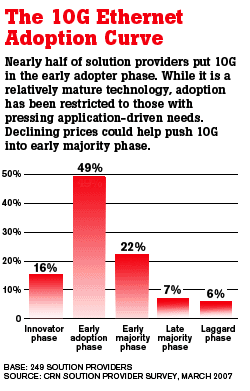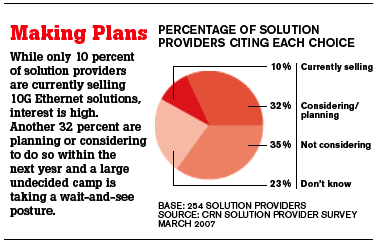Stepping Up To 10G
Imagine a data center with 250 servers. From midnight to 2 a.m. every day, the servers replicate to a single target that will later stream the data to tape. There's about 2.5 Gbps of throughput streaming over a 1-Gbps connection.
It may be time to upgrade the corporate backbone.
That's the way a lot of companies are seeing it. As much as 15 percent to 20 percent of companies are committed to upgrading some portion of their backbone and a "huge" percentage are planning to do so in the near term, said Robert Whiteley, a senior analyst at Forrester Research.
After the hiatus following the last major backbone overhaul during the Internet boom years, some companies began upgrading their networks in 2005, but most are beginning a major overhaul now, as applications such as e-mail, video and storage networking raise the need for more bandwidth, Whiteley said.
For SMB solution providers, the picture is not so clear. Many small businesses that upgraded to Gigabit Ethernet are still floating in bandwidth, while the step up to 10-Gigabit Ethernet is a very big step, indeed, in both cost and capacity.
Solution provider NWN, Waltham, Mass., has upgraded the backbone of some of its larger customers to 10G Ethernet, including East Carolina University, which connected its east campus with medical buildings four miles away so that data could be replicated. Chris Ludwig, regional director of practice management at NWN, said he is beginning to see more and more data replication, which is driving a need for bandwidth.
But not all customer networks are at the same place to take advantage of the latest in networking. For another network integration firm, D&D Consulting, Albany, N.Y., many of its clients are still transitioning from Layer 2 and Layer 3 or to Gigabit Ethernet, said CEO Chris Labatt-Simon. Still, customers are upgrading.
The Upgrade Hurdle
While the network backbone usually undergoes many minor improvements in its lifetime, upgrading to a newer technology requires that most, if not all, equipment needs to be replaced. Because of the cost, customers tend to ask: "Is there a real need for an upgrade? Can I get by with what I have for another year?" Ludwig said.
Solution providers install new switches and cards in order to upgrade to Fast Ethernet or Gigabit Ethernet. It's not as simple with 10-Gigabit Ethernet since it usually runs on fiber and requires new network cards, switches and routers. Even for the newer standard that runs on copper, connectors have to be replaced.
Despite falling costs and increasing need for bandwidth, 10G Ethernet remains a specialized niche. Nearly half of the solution providers in the March CRN monthly poll placed 10G in the early adopter phase—even though it's considered a mature technology—and only 10 percent were currently selling 10G Ethernet solutions.
It is largely an enterprise play. Businesses with fewer than 1,000 users are not even thinking about it, Ludwig said. While some do data mirroring, most are not yet fully using the capacity in their Gigabit Ethernet backbones. Another solution provider estimated he sees only about 15 percent utilization on the network backbone. Still, 32 percent of the solution providers in the poll said they were either considering or planning to offer 10G solutions within the next year in a sure sign that 10G is gaining steam.
Next: What's Driving Upgrades
What's Driving Upgrades
Why upgrade? Network upgrades tend to occur in four- to five-year cycles as customers replace old equipment for newer and faster devices, Labatt-Simon said. Age is an important consideration because vendors eventually stop supporting obsolete equipment.
Applications, though, are the true driver for backbone upgrades. Whiteley said enterprises are seeing 100 percent growth in network traffic year over year.
Applications have become truly distributed, which means that as the hardware they run on becomes faster and more powerful, the network becomes more of a bottleneck. Video is a common example.

Although video servers have gotten much more bandwidth-efficient by using multicasting and compression to keep throughput down, video that is viewed simultaneously by a large number of employees can still strain the network.
This is particularly true in on-demand situations where multicasting is not possible. If there is not enough bandwidth, only a subset of employees will be able to see the video, said Tony Stramandinoli, vice president of marketing at SMC Networks, Irvine, Calif., a networking vendor. Images may be jittery and file transfers may take longer.
"It's not just e-mail anymore. There's streaming video, video over network, voice over IP," he said.
Customers may be interested in deploying other applications such as large file transfers, networkwide backups, systemwide application launches, increased network storage or document imaging, which make greater demands on the network.
Business-continuity and disaster-recovery solutions also are driving interest in upgrading the backbone, Whiteley said. Outages are costly in terms of productivity and replicating data means companies can be up and running faster.
Even without a pressing need, companies may consider upgrading portions of the backbone to 10G if they are putting in new construction, renovating existing space or moving to a new location. With the cost of 10G dropping, customers are more willing to invest in 10G to "future-proof" their networks, Whiteley said.
Next: Spotlight On 10G
Spotlight On 10G
There's no one metric that indicates how large the market is for upgrading the backbone, but one way to gauge the market is to look at the nuts and bolts of networking: switches and routers.
Enterprise-class router unit shipments grew 14 percent in 2005, accounting for $3.3 billion in revenue, Infonetics Research reported. The market researcher forecast that annual unit shipments would grow another 41 percent by 2009 to $4.5 billion. Infonetics noted that while 10G is the fastest-growing segment, the bulk of the growth is still primarily in Gigabit Ethernet. Annual revenue for 10-Gigabit Ethernet switch port shipments topped $1 billion in 2006, IDC reported.
While 10-Gigabit Ethernet is still expensive compared to Gigabit Ethernet, prices are falling. The price of 10-Gigabit Ethernet fiber ports have dropped to about seven to eight times the price of Gigabit. For some vendors, it is trending even lower, approaching $1,000 per port. Contributing to the decline has been the development of a 10GbaseT standard for copper. According to SMC, if 10G Ethernet over fiber was $3,000 per port, then 10G Ethernet over copper cable would be about $1,000 per port.
According to Nelson Murga, product manager at networking vendor Ixia, copper is preferable to fiber because it takes advantage of existing infrastructure and is much easier to run. Fiber has more complexity, which may be a bit daunting. However, the physical distance limitations mean 10GbaseT over copper will more likely be used to connect data centers over short distances, rather than connecting large campuses.
A CAT6 cable can go up to 55 meters, while CAT6a and CAT7 can extend to 100 meters. A regular CAT5 cable is capable of only 30 meters. In contrast, Gigabit Ethernet over fiber extends 5 kilometers, and 10G Ethernet over fiber stretches to 40 kilometers. Vendors also are developing proprietary optics to increase the distance to 100 kilometers and further.
While copper is bringing the price down, there are other options to a 10G upgrade. If the customer does not need 10G, but Gigabit Ethernet is just not enough, one option is to bond several single Gigabit Ethernet networks together to create a larger pipe. This is a more flexible solution, especially if the customer will not be needing 10G for a long time. By the time the customer outgrows the aggregate trunk, the price for 10G would likely have fallen further and there may even be other options available.
Selling The Solution
When it comes to selling network upgrades, Labatt-Simon has an odd complaint. He said that the sales cycle is often "too short." Clients are reactive, not proactive, for they think about upgrades after they've already deployed an application on to the network, he said. At this point, the client is interested in a quick solution to get everything working, and the network assessment is rushed in order to get to the upgrade. There's no time to properly rearchitect the network.
Properly done, the assessment should last at least two to three weeks, and implementation should take anywhere from a little less than a month to a full year, depending on the network's complexity, he said. About 40 percent of the solution providers concurred in the recent CRN poll, saying the typical sales cycle is between two and four months.
Solution providers look at the current network utilization and determine the network's current usage loads and future needs in terms of applications and user size. NWN creates simulations based on the customer's network usage to discover patterns that can be used in capacity planning, Ludwig said.
The data center and backbone network utilization growth will provide a reasonable benchmark for when it will cross the 10G threshold. Administrators generally don't want to operate the network at more than 50 percent utilization because spikes and peak traffic can cause performance issues when the load creeps up.
Next: Room For New Vendors
Room For New Vendors
A bevy of vendors are ready to capitalize on the growth potential behind 10G.
The big names such as Cisco Systems and Foundry Networks have been delivering 10G products for years, but there has still been ample room for newcomers to enter the market, despite the slow rate of 10G adoption over the past five years.
What has attracted new vendors to the space is the simple fact that price-per-port declines are making the technology more affordable for businesses. Add to that the rapid adoption of new on-demand technologies such as VoIP and video and the need for more bandwidth becomes readily apparent.
But many solution providers still wonder: What makes one vendor different from another in the 10G space? While 10G has not approached commodity status as of yet, price per port may very well be the answer to that query.

There is no denying that as the vendor list grows, competition drives prices lower. That has a direct impact on margins and profits associated with selling the hardware. As availability and adoption scales up for 10G, solution providers will need to shift their focus from margins to service opportunities and design services.
A vendor's ability to support that shift will become the deciding factor in how most solution providers will choose their partner. Another critical element for solution providers will be technical support and product MTBF (mean time between failure). After all, 10G products will be deployed into the most critical of network areas where downtime must be completely avoided.
Whether it's a product's failover capabilities, a vendor's rapid replacement program or failure mitigation technologies, solution providers will have to balance cost against uptime promises to make a final decision on selecting a vendor.
For most VARs, the biggest promise in the 10G arena is the arrival of 10G over copper, which removes the complexity and costs associated with traditional 10G fiber-based solutions and reduces both deployment and price-per-port costs. Combining copper 10G with IP storage technologies such as iSCSI will create one of the biggest opportunities for VARs looking to profit from 10G Ethernet, along with business-continuity, disaster-recovery and virtualization solutions.